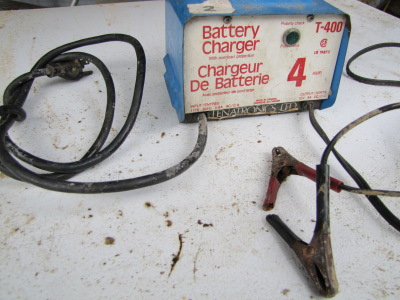
Trickling compared to a quick boost
 We found this battery charger at a
thrift store for 5 dollars back when we first started collecting tools.
We found this battery charger at a
thrift store for 5 dollars back when we first started collecting tools.
It usually takes all night
for a full charge compared to just a few minutes with the unreliable 5
in 1 portable power packs.
Makes me wonder if it's
easier on the battery to do the slow trickle charge?
Want more in-depth information? Browse through our books.
Or explore more posts by date or by subject.
About us: Anna Hess and Mark Hamilton spent over a decade living self-sufficiently in the mountains of Virginia before moving north to start over from scratch in the foothills of Ohio. They've experimented with permaculture, no-till gardening, trailersteading, home-based microbusinesses and much more, writing about their adventures in both blogs and books.
Want to be notified when new comments are posted on this page? Click on the RSS button after you add a comment to subscribe to the comment feed, or simply check the box beside "email replies to me" while writing your comment.

I like to trickle charge my older lead-acid batteries. As batteries age crystals build up (sulphation) on the lead plates causing more resistance which results as heat. Charging with high current 6A+ can result in shorts between cells giving you a dead cell. This is easy to test for by putting one end of your multimeter in the acid and the other on a battery terminal post.
I've seen people zap batteries with huge amounts current which is crazy dangerous, but can help recover the battery by breaking down the crystals. If the battery doesn't blow up on you. Admittedly I've zapped old NiCD cells with a welder to bring them back, but have much better results just using a capacitive charger or battery desulfator with trickle charger.
For vented cell lead-acid batteries there are defined procedures for reviving "dead" batteries. You can find a good overview of the problem and possible solutions in the context of batteries for PV systems here. You'll need a hydrometer and a thermometer (because hydrometers are usually callibrated at a certain temperature) to check the specific gravity of the battery acid.
It should be noted that no recovery if possible when the material has fallen off the plates and landed on the bottom of a battery, or if a cell has shorted out.
Generally, VRLA batteries (especially AGM batteries) have a lot of advantages over vented batteries, notably a higher cherge efficiency, higher power density and a low self-discharge rate. See the linked article for a complete overview.